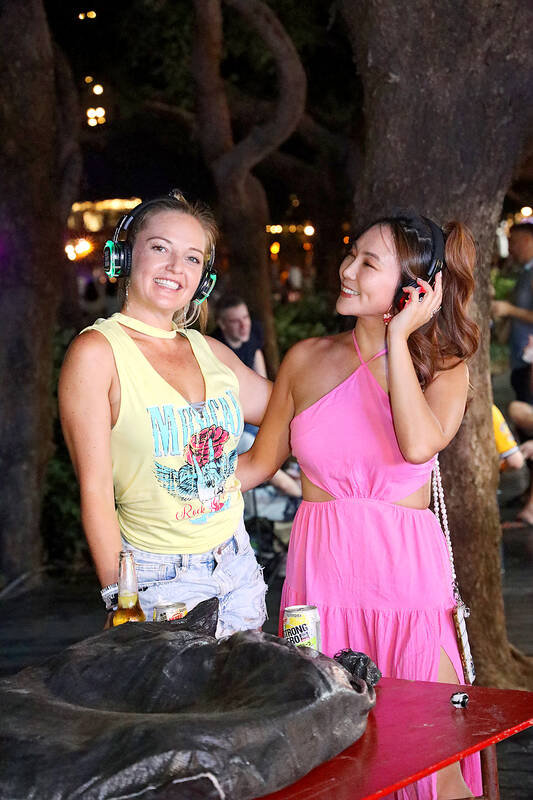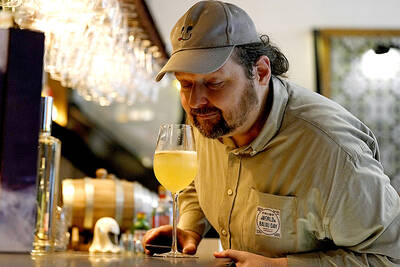You’ve got hip DJs blasting out some beats. And a sea of partygoers swaying to the tunes. But hold the speakers, please, for it’s a hushed-down outdoor dance party.
This trendy Silent Party, with two DJs simultaneously playing different styles of music through a special set of color-coded headphones, will be part of this weekend’s Compass Taichung International DJ and Food Festival.
“Taichung is known as the city of perennial noise complaints,” said Douglas Habecker, co-publisher of Compass Magazine, which is hosting the event. “So the Silent Party helps.”

Photo courtesy of Compass Magazine
The two-day festival will take place on the pedestrian-friendly Calligraphy Greenway from noon to 9pm Saturday and noon to 8pm Sunday, with the Silent Party portion held in the evenings. In addition to Compass, the event is put on by La Bocca Studio and Silent Party Taiwan.
Organizers hope the first-time festival will attract a broad audience, including families and older adults, and not just fans of DJ house music. During the daytime DJs will be playing a range of music from hip-hop to funk, with even some country line dancing to get the crowd moving.
“We want music that is accessible, fun to listen to and enjoyable to everyone,” Habecker said.
In addition to music, the festival will feature around 30 vendors selling both Taiwanese and western food and beverages.
With the city’s jazz festival and Compass’s live music festival occurring in the fall, organizers saw an opportunity to offer up something in the spring, which can be a quiet time of year for outdoor music events.
“Why not have something early in the year and later in the year?” said Habecker, adding that he hopes this weekend’s festival focusing on DJs will become an annual event that will grow larger in coming years.

The unexpected collapse of the recall campaigns is being viewed through many lenses, most of them skewed and self-absorbed. The international media unsurprisingly focuses on what they perceive as the message that Taiwanese voters were sending in the failure of the mass recall, especially to China, the US and to friendly Western nations. This made some sense prior to early last month. One of the main arguments used by recall campaigners for recalling Chinese Nationalist Party (KMT) lawmakers was that they were too pro-China, and by extension not to be trusted with defending the nation. Also by extension, that argument could be

Aug. 4 to Aug. 10 When Coca-Cola finally pushed its way into Taiwan’s market in 1968, it allegedly vowed to wipe out its major domestic rival Hey Song within five years. But Hey Song, which began as a manual operation in a family cow shed in 1925, had proven its resilience, surviving numerous setbacks — including the loss of autonomy and nearly all its assets due to the Japanese colonial government’s wartime economic policy. By the 1960s, Hey Song had risen to the top of Taiwan’s beverage industry. This success was driven not only by president Chang Wen-chi’s

Last week, on the heels of the recall election that turned out so badly for Taiwan, came the news that US President Donald Trump had blocked the transit of President William Lai (賴清德) through the US on his way to Latin America. A few days later the international media reported that in June a scheduled visit by Minister of National Defense Wellington Koo (顧立雄) for high level meetings was canceled by the US after China’s President Xi Jinping (習近平) asked Trump to curb US engagement with Taiwan during a June phone call. The cancellation of Lai’s transit was a gaudy

The centuries-old fiery Chinese spirit baijiu (白酒), long associated with business dinners, is being reshaped to appeal to younger generations as its makers adapt to changing times. Mostly distilled from sorghum, the clear but pungent liquor contains as much as 60 percent alcohol. It’s the usual choice for toasts of gan bei (乾杯), the Chinese expression for bottoms up, and raucous drinking games. “If you like to drink spirits and you’ve never had baijiu, it’s kind of like eating noodles but you’ve never had spaghetti,” said Jim Boyce, a Canadian writer and wine expert who founded World Baijiu Day a decade